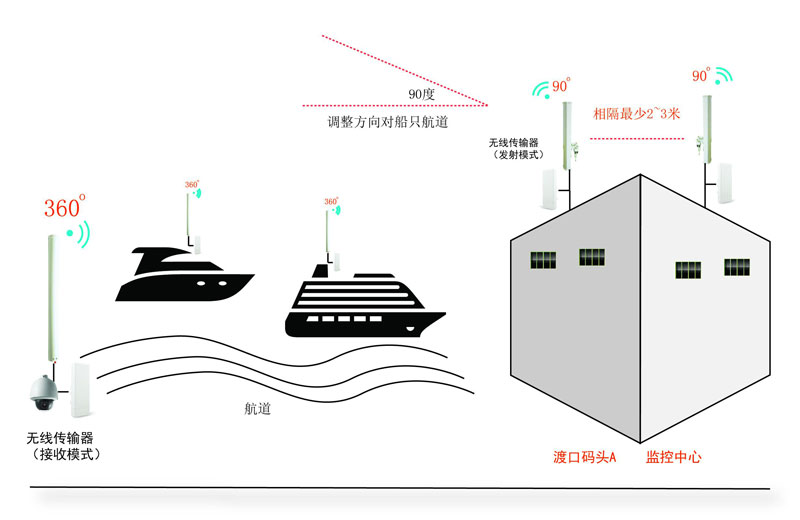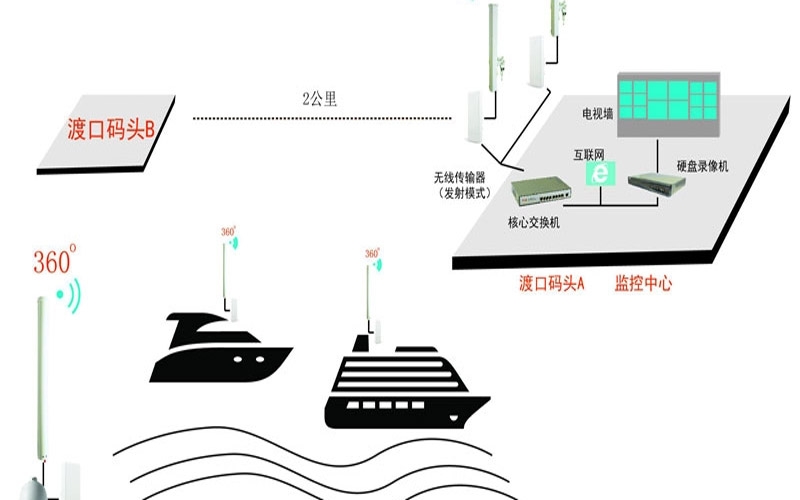Bai-link Communication Ferry Wireless Monitoring Solution Case
A city's transportation and maritime affairs department said that in view of the fact that Zhongshan has a dense water network and numerous ferries, a comprehensive investigation of the ferries operated by the city has been conducted since 2002. Combined with the development of roads and bridges in our city, the ferry configuration has been optimized. The ferries with unreasonable settings and low passenger flow will be withdrawn and merged, reducing the number of ferries in the city to the current 29. Since 2004, the retained ferries have been renovated and renovated, and facilities such as waiting booths have been built for qualified ferries, ensuring that the quality of ferries meets the standards and fundamentally improving the safety conditions of ferries and the ferry environment in our city. At the same time, our city has further improved the water transportation safety facilities at ferries and strengthened the safety management of ferries. It is understood that since 2002, there have been no casualties in water transportation in our city, and since 2007, there have been "zero accidents."
However, relevant departments also admitted that due to reasons such as insufficient sound management mechanisms, insufficient investment in safety management, low quality of ferry workers, and insufficient complete ferry facilities and equipment, ferries still have safety hazards.
Implement video surveillance of city crossings
Chen Genkai pointed out that ferries are one of the important means of transportation in Zhongshan. There are many ferry passengers every year, and water transportation safety cannot be ignored. Relevant departments and towns should attach great importance to this and strengthen the safety management of ferries and ensure safety.
Chen Genkai put forward requirements for strengthening the safety management of ferries at ferries: strictly enforce the standards for ferries at ferries, and the threshold cannot be lowered, and those who fail to meet the standard requirements must be stopped; strictly enforce the operating standards of boatmen. Transportation, maritime and other departments must perform their duties and conduct regular training. Boatmen who fail to meet the requirements cannot take up their posts; relevant departments, towns and villages must clarify their responsibilities and assume their responsibilities, and organize special safety inspections every year; Increase investment, strengthen emergency management at crossings, accelerate the construction of video surveillance system upgrade projects, and improve the level of safety supervision.
It is understood that in April this year, the municipal government invested 1.8 million yuan to support the maritime department in launching the city's ferry video surveillance system upgrade project, which has now entered the bidding and construction stage. This information system has advanced functions. After completion, it can achieve all-weather monitoring. Even in severe weather such as typhoons, heavy rains, and fog, it can be "visible, called, coordinated, and commanded."

Project overview:
1. This project implements video surveillance for ferries at ferries.
2. The distance between the ferry and the other bank is about 2 kilometers.
3. There are 10 ferries passing by, and each ship is equipped with a 720P video surveillance camera.
4. The ship is driving on the specified route, with a width of 20 meters; and the ship needs to turn around at the ferry.
2. Network architecture design system topology diagram:
Networking instructions:
1. Wireless APs are divided into multiple working groups and connected by wire to form a backbone network with more stable performance.
2. Ferry Terminal A (monitoring center) uses SMA's wireless transmitter external sector antenna equipment. It is recommended to use the wireless AP BWA3000D developed and produced by Bai-link Company. This model uses Qualcomm AR9344 + SE2576L chips, has a transmission rate of 300Mbps, an effective coverage area of 3 kilometers, and an orientation of 90 degrees; adjust the antenna direction to face the ship's fixed route, and set the equipment to transmit mode.
3. The ship is equipped with an external omnidirectional 360-degree antenna equipment using SMA wireless transmitter. It is recommended to use the wireless AP303C developed and produced by Bai-link Company. This model uses Qualcomm AR9341 + SE2576L chips, has a transmission rate of 300Mbps, and the equipment is set to receive mode.
4. Due to working on water, the humidity in the air is 100%. Channels from 2.3 to 2.7GHz are recommended for equipment.

scheme analysis
1. In this plan, the front-end camera of the ship uses a 720P network camera. The front-end camera occupies about 4M of bandwidth, and the effective bandwidth of the equipment is 40MB/S. There are ten 720P network cameras in ten ships, so two transmission signal working groups need to be built.
2. At the rear end of the ferry, the positions of launching group A and launching group B must be separated by at least 2 to 3 meters during installation. The main purpose is to avoid the problem of equipment and equipment itself being poor due to similar equipment and too strong information.
3. SMA wireless transmitter external omnidirectional 360-degree antenna equipment is installed on the top of the ship. The main purpose of using 360-degree is to avoid wire disconnection when the ship turns and turns.













